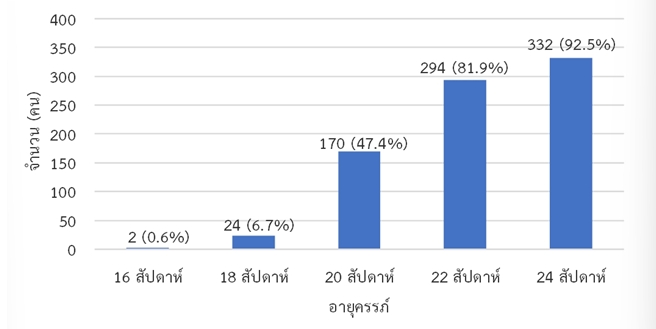The study of the proportions of couples who obtained their at-risk/non-risk results and prenatal diagnosis outcomes of severe thalassemia within various gestational ages
Keywords:
At-risk couple, Prenatal diagnosis, ThalassemiaAbstract
Each step of the prenatal screening for thalassemia is subject to time constraints. This study aimed to demonstrate the outcome of a thalassemia prenatal control program by determining the proportions of couples who obtained their at-risk/non-risk results and their prenatal diagnosis (PND) outcomes within various gestational ages (GA). The study was conducted using prenatal control record for thalassemia disease in the lower northern region between January 2014 and December 2016. Pregnancies without record of GA were excluded. Proportions of couples who received their at-risk/non-risk and PND results within the GA of 16 through 24 weeks were analyzed. Among 4,633 couples determined, the median GA was 12.4 weeks when blood samples were submitted for thalassemia screening, and 13.9 weeks when at-risk/non-risk results were communicated. Proportions of couples who obtained their at-risk/non-risk results within the GA of 16, 18, and 20 weeks were 64.9% (3,005 cases), 73.8% (3,421 cases), and 81.2% (3,761 cases), respectively. Among 359 PNDs evaluated, the median GA was 18.0 weeks when the PND was performed and 20.1 weeks when the PND results were disclosed. Proportions of couples who obtained their PND results within the GA of 16, 18, 20, 22, and 24 weeks were 0.6% (2 cases), 6.7% (24 cases), 47.4% (170 cases), 81.9% (294 cases), and 92.5% (332 cases), respectively. This outcome could reflect our real-world efficacy of prenatal control program for thalassemia in the lower northern region which needs improvement.
References
Nipaporn S, Pannarunothai S, Wong P. Thalassemia control in pregnant women in Phitsanulok, 2000-2004. Buddhachinaraj Medical Journal 2005; 22:209-222.
Muennoy N, Jopang Y, Puangpruk R, Netnee P. The study of prevention and control program for thalassemia in Nakhon Ratchasima province. The 5th Health Center Region, Nakhon Ratchasima 2010. [Cited 2020 August 17] Available from: http://203.157.71.139/group_sr/allfile/1418714861.pdf
Department of Health. Rate of pregnant women attended their first antenatal care within 12 weeks of gestation, key performance indicator. Department of Health 2017. [Cited 2020 August 17] Available http://M201600002-1479882138-keyperformanceindicator-2560-081159(2).pdf
Soontornprakasit P, Mongkolchati A, Chompikul J. Factors associated with time to start antenatal care within 12 weeks gestational age among mothers in Mahasarakham province, Thailand. J Public Health Dev 2016;14(1):21-36.
Srithipayawan S, Wong P, Chattrapiban T. Iron deficiency anemia during pregnancy in the lower north of Thailand - prevalence and associated factors. Malaysian Journal of Public Health Medicine 2012;12:1-5.
Wong P, Suannum P, Jermnim S, Charoenporn P, Chan-In M, Tapprom A, Deoisares R. Lessons learned from a Prenatal diagnosis program for thalassemia in Thailand. Prenat Diagn 2020;40(18): 998-1004.
The Royal Thai College of Obstetricians and Gynaecologists. Guideline for prenatal screening and diagnosis of thalassemia 2009. [Cited 2020 August 17] Available from: http://www.rtcog.or.th/home/
Suwannakhon N, Pongsawatkul K, Seeratanachot T, et al. The shortcut strategy for beta thalassemia prevention. Hematol Rep 2018;10(2):7530. https://doi.org/10.4081/hr.2018.7530
Jenkins LA, Deans ZC, Lewis C, Allen S. Delivering an accredited non-invasive prenatal diagnosis service for monogenic disorders and recommendations for best practice. Prenat Diagn 2018;38(1):44-51.

Downloads
Published
How to Cite
Issue
Section
License
Copyright (c) 2023 Naresuan Phayao Journal

This work is licensed under a Creative Commons Attribution-NonCommercial-NoDerivatives 4.0 International License.
ผู้นิพนธ์ต้องรับผิดชอบข้อความในบทนิพนธ์ของตน มหาวิทยาลัยพะเยาไม่จำเป็นต้องเห็นด้วยกับบทความที่ตีพิมพ์เสมอไป ผู้สนใจสามารถคัดลอก และนำไปใช้ได้ แต่จะต้องขออนุมัติเจ้าของ และได้รับการอนุมัติเป็นลายลักษณ์อักษรก่อน พร้อมกับมีการอ้างอิงและกล่าวคำขอบคุณให้ถูกต้องด้วย
The authors are themselves responsible for their contents. Signed articles may not always reflect the opinion of University of Phayao. The articles can be reproduced and reprinted, provided that permission is given by the authors and acknowledgement must be given.







